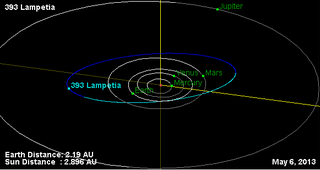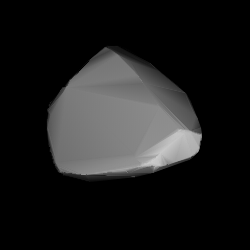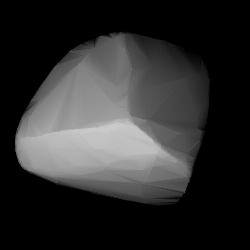Related Research Articles

393 Lampetia is a fairly large main belt asteroid that was discovered by German astronomer Max Wolf on 4 November 1894 in Heidelberg. It has an unusually low rotation rate, with a period estimated at 38.7 hours and a brightness variation of 0.14 in magnitude.
431 Nephele is a large Themistian asteroid. It is spectral C-type and is probably composed of carbonaceous material.
525 Adelaide is an S-type asteroid belonging to the Flora family in the Main Belt. It was discovered 21 October 1908 by Joel Hastings Metcalf.

534 Nassovia is a minor planet orbiting the Sun. It is a member of the Koronis family of asteroids.
654 Zelinda is a minor planet orbiting the Sun that was discovered on 4 January 1908 by German astronomer August Kopff. On favorable oppositions, it can be as bright as magnitude 10.0, as on January 30, 2016.
657 Gunlöd is a dark background asteroid orbiting in the intermediate asteroid belt, approximately 43 kilometres (27 mi) in diameter. It was discovered on 23 January 1908, by astronomer August Kopff at the Heidelberg Observatory in southwest Germany. It has an albedo of around 0.042 and a rotation period of 15.7 hours.
658 Asteria is a minor planet orbiting the Sun.
661 Cloelia is a minor planet orbiting the Sun that was discovered by American astronomer Joel Hastings Metcalf on February 22, 1908.
660 Crescentia is a minor planet orbiting the Sun that was discovered by American astronomer Joel Hastings Metcalf on January 8, 1908. The name may have been inspired by the asteroid's provisional designation 1908 CC. Peter Ting points out that the Rev. Joel Metcalf of Taunton (Massachusetts) discovered six asteroids with unexplained names, though listed in Lutz Schmadel's book. Ting used an on-line planetarium website to help with the location of some of the planets, playing back to the night of discovery. He noticed that there was a crescent moon (33%) low in the western sky and wonders if the Rev. Metcalf could have named the asteroid for the Moon. Crescentia would be a very unusual name for a person but not for a phase of the Moon.

662 Newtonia is a minor planet, specifically an asteroid orbiting mostly in the asteroid belt.
663 Gerlinde is a minor planet orbiting the Sun.
664 Judith is a minor planet orbiting the Sun. It was named after the biblical character Judith.
668 Dora is an asteroid orbiting in the asteroid belt located roughly between the orbits of the planets Mars and Jupiter. The name may have been inspired by the asteroid's provisional designation 1908 DO.

669 Kypria is a minor planet orbiting the Sun that was discovered by German astronomer August Kopff on August 20, 1908.
671 Carnegia is a minor planet orbiting the Sun.
672 Astarte is a minor planet orbiting the Sun.

673 Edda is a minor planet orbiting the Sun. It was discovered 20 September 1908 by the American astronomer Joel Hastings Metcalf, and was named for the Norse Edda literary works. The name may also have been inspired by the asteroid's provisional designation 1908 EA. This asteroid is orbiting at a distance of 2.81 AU with a period of 4.72 yr and an eccentricity of 0.012. The orbit is close to a 5:2 mean motion resonance with Jupiter, which is located at 2.824 AU.
670 Ottegebe is a minor planet orbiting the Sun. In 2007 lightcurve data showed that Ottegebe rotates every 10.041 ± 0.002 hours. The name refers to a character in Gerhardt Hauptmann's play Der arme Heinrich. It is orbiting close to a 5:2 mean motion resonance with Jupiter, which is located at 2.824 AU.
972 Cohnia is a minor planet orbiting the Sun, one of several such in the asteroid belt. It was discovered on 18 January 1908 by a team in Heidelberg led by Max Wolf. In 2007, lightcurve data showed that Cohnia rotates every 18.472 ± 0.004 hours.
2021 LL37 is a large trans-Neptunian object in the scattered disc, around 600 kilometres (370 miles) in diameter. It was discovered on 12 June 2021, by American astronomers Scott Sheppard and Chad Trujillo using Cerro Tololo Inter-American Observatory's Dark Energy Camera in Chile, and announced on 31 May 2022. It was 73.9 astronomical units from the Sun when it was discovered, making it one of the most distant known Solar System objects from the Sun as of May 2022. It has been identified in precovery images from as far back as 28 April 2014.
References
- ↑ "667 Denise (1908 DN)". JPL Small-Body Database . NASA/Jet Propulsion Laboratory . Retrieved 5 May 2016.